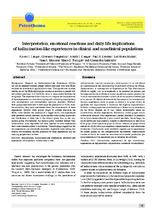Mostrar el registro sencillo del ítem
Interpretation, emotional reactions and daily life implications of hallucination-like experiences in clinical and nonclinical populations
| dc.contributor.author | Langer, Álvaro I. | |
| dc.contributor.author | Stanghellini, Giovanni | |
| dc.contributor.author | Cangas, Adolfo J. | |
| dc.contributor.author | Lysaker, Paul H. | |
| dc.contributor.author | Nieto-Muñoz, Luz | |
| dc.contributor.author | Moriana Elvira, Juan Antonio | |
| dc.contributor.author | Barrigón, María L. | |
| dc.contributor.author | Ambrosini, A. | |
| dc.date.accessioned | 2020-04-01T19:38:49Z | |
| dc.date.available | 2020-04-01T19:38:49Z | |
| dc.date.issued | 2015 | |
| dc.identifier.uri | http://hdl.handle.net/10396/19861 | |
| dc.description.abstract | Background: Research on Hallucination-Like Experiences (HLEs) has not yet explored whether people without psychosis who have HLEs attribute the same level of significance to them. This signifi cance includes whether or not the HLEs elicit similar emotional reactions in people with and without psychosis, or if the HLEs occur in same context between the two groups. The objective of this study was to compare the characteristics of these experiences in a non-clinical group and a clinical group of patients with schizophrenia and schizophrenia spectrum disorders. Method: Both groups were evaluated to determine the prevalence of HLEs. After the evaluation, they were interviewed about the characteristics of these experiences. Results: Both groups sought to actively eliminate the HLEs, could identify the presence of a trigger factor, and experienced little perceived control. However, HLEs elicited more anxiety, discomfort and interference in daily life in the clinical group than in the nonclinical group. Furthermore, the clinical group members defi ned their hallucinations more negatively and were reported to have experienced them under stressful events. Conclusions: These findings suggest that the two experiences are not entirely equivalent, especially when taking into account the emotional reaction produced by these experiences and the meaning people attach to them. | es_ES |
| dc.description.abstract | Interpretación, reacción emocional e implicaciones en la vida diaria de experiencias de tipo alucinatorias en población clínica y no clínica. Antecedentes: la investigación en Experiencias de Tipo Alucinatorias (HLEs en inglés) aún no ha explorado si las personas sin psicosis que las experimentan les atribuyen el mismo signifi cado, si estas provocan las mismas reacciones emocionales o si ocurren en los mismos contextos que en la psicosis. El objetivo de este estudio fue comparar las características de estas experiencias entre un grupo no clínico y un grupo clínico de pacientes con esquizofrenia y trastornos del espectro esquizofrénico. Método: ambos grupos fueron evaluados para determinar la prevalencia de las HLEs, después de lo cual fueron entrevistados sobre las características de estas experiencias. Resultados: ambos grupos buscan activamente eliminar estas experiencias; pueden identificar la presencia de un factor desencadenante, y poco control percibido. Sin embargo, las HLEs provocaron más ansiedad, malestar e interferencia en la vida diaria en el grupo clínico que en el grupo no clínico. Además, el grupo clínico definió sus HLEs como más negativas y experimentadas bajo situaciones estresantes. Conclusiones: estos resultados sugieren que las experiencias de ambos grupos no son completamente equivalentes, especialmente cuando se toman en cuenta las reacciones emocionales producidas por estas experiencias y el significado que las personas les atribuyen. | es_ES |
| dc.format.mimetype | application/pdf | es_ES |
| dc.language.iso | eng | es_ES |
| dc.publisher | Colegio Oficial de Psicólogos del Principado de Asturias; Universidad de Oviedo. Facultad y Departamento de Psicología | es_ES |
| dc.rights | https://creativecommons.org/licenses/by-nc-nd/4.0/ | es_ES |
| dc.source | Psicothema 27(1), 19-25 (2015) | es_ES |
| dc.subject | Hallucination | es_ES |
| dc.subject | Hallucination-like experiences | es_ES |
| dc.subject | Psychotic-like experiences | es_ES |
| dc.subject | Schizophrenia | es_ES |
| dc.subject | Vulnerability model | es_ES |
| dc.subject | Alucinaciones | es_ES |
| dc.subject | Experiencias de tipo alucinatorias | es_ES |
| dc.subject | Experiencias de tipo psicóticas | es_ES |
| dc.subject | Esquizofrenia | es_ES |
| dc.subject | Modelo de vulnerabilidad | es_ES |
| dc.title | Interpretation, emotional reactions and daily life implications of hallucination-like experiences in clinical and nonclinical populations | es_ES |
| dc.type | info:eu-repo/semantics/article | es_ES |
| dc.relation.publisherversion | http://dx.doi.org/10.7334/psicothema2014.97 | es_ES |
| dc.rights.accessRights | info:eu-repo/semantics/openAccess | es_ES |

